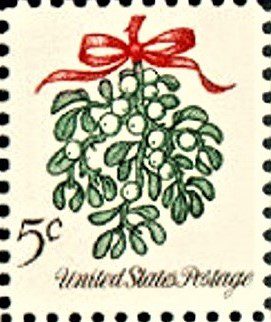All of Carthage is beginning to twinkle and sparkle calling forth favorite traditions. Now is the time for mistletoe with pearl-like berries that ripen in December and leaves that remain vibrant all winter. Decorating our homes with boughs of greenery beautifully celebrates our love for nature as overhead trees grow winter bare.
The ancient Greeks revered mistletoe for healing properties that provided medicine for pain relief and for conditions of gastronomical upset. The Druids considered mistletoe so sacred as to be cut with a golden sickle. Sprigs over doors signified abodes of shelter and protection and brought good luck and protection against evil spirits. In Norse mythology mistletoe symbolized love. This is perhaps the origin for the custom of kissing under hanging mistletoe.
Mistletoe was among the plants adopted by Christians in celebration of Christmas. They considered the evergreen leaves to symbolize “life that does not die”, longevity, fertility, good luck, health and an abundant harvest in the months to come. The Victorians, taken with mistletoe as a symbol of fertility, life and romance, carried on the tradition of kissing beneath mistletoe.
Mistletoe grows parasitically on twigs; hence the origin of the name. The English word “mistletoe” derived from a defunct Anglo-Saxon dialect with “mistel” the word for the dung of bird droppings on tree branches and “tan” meaning twig. These two words conjoined as “mistletan” and evolved over time into “mistletoe”.
Most mistletoe seeds are spread by birds, which eat the berries and leave their droppings on tree limbs. If attached to a new host tree, the parasitic seeds release a compound called “viscin” which dries to form a stiff biological cement. While poisonous to pets, mistletoe is a good food source for birds eating the berries and butterflies, bees and a variety of insects dining on the nectar.
Globally more than 900 species of mistletoe can be found. Most familiar is the European (Viscum album) which we use for decorating. Mistletoe is found across North America. Native to Australia is a variety bearing elongated red berries.
Not all tree species are friendly hosts for mistletoe. Those most suitable include hawthorn, blackthorn, rowan, most apple varieties, willows, plum, lime and poplar. Mistletoe self-produces food through photosynthesis, while taking minerals and water from the host tree.
Male plants produce the pollen. Females produce the berries. To propagate mistletoe, fresh berries harvested from a mistletoe sow, are pushed underneath loosened bark in nooks or crannies of thicker, sunny tree branches where mistletoe is wished to grow. If the seeds successfully germinate green leaves will appear, and in three or four years small clumps will form.
Now that the time for mistletoe has come, remember…to refuse a kiss under the mistletoe is considered bad luck. After a kiss a couple is to pluck one berry to be fed to the birds. When all the berries are gone the bough is thought to lose the power to command kisses, so when you hang your mistletoe be sure to choose a very large spray!















